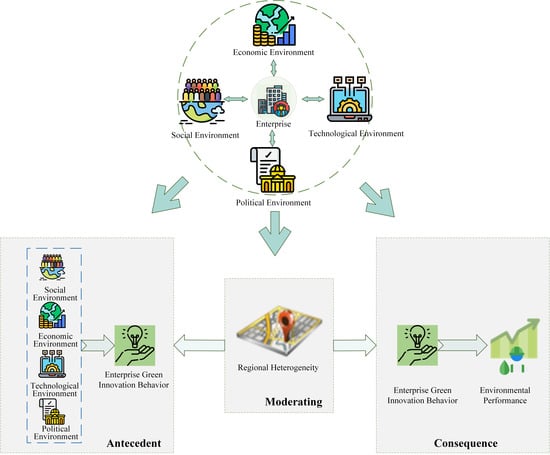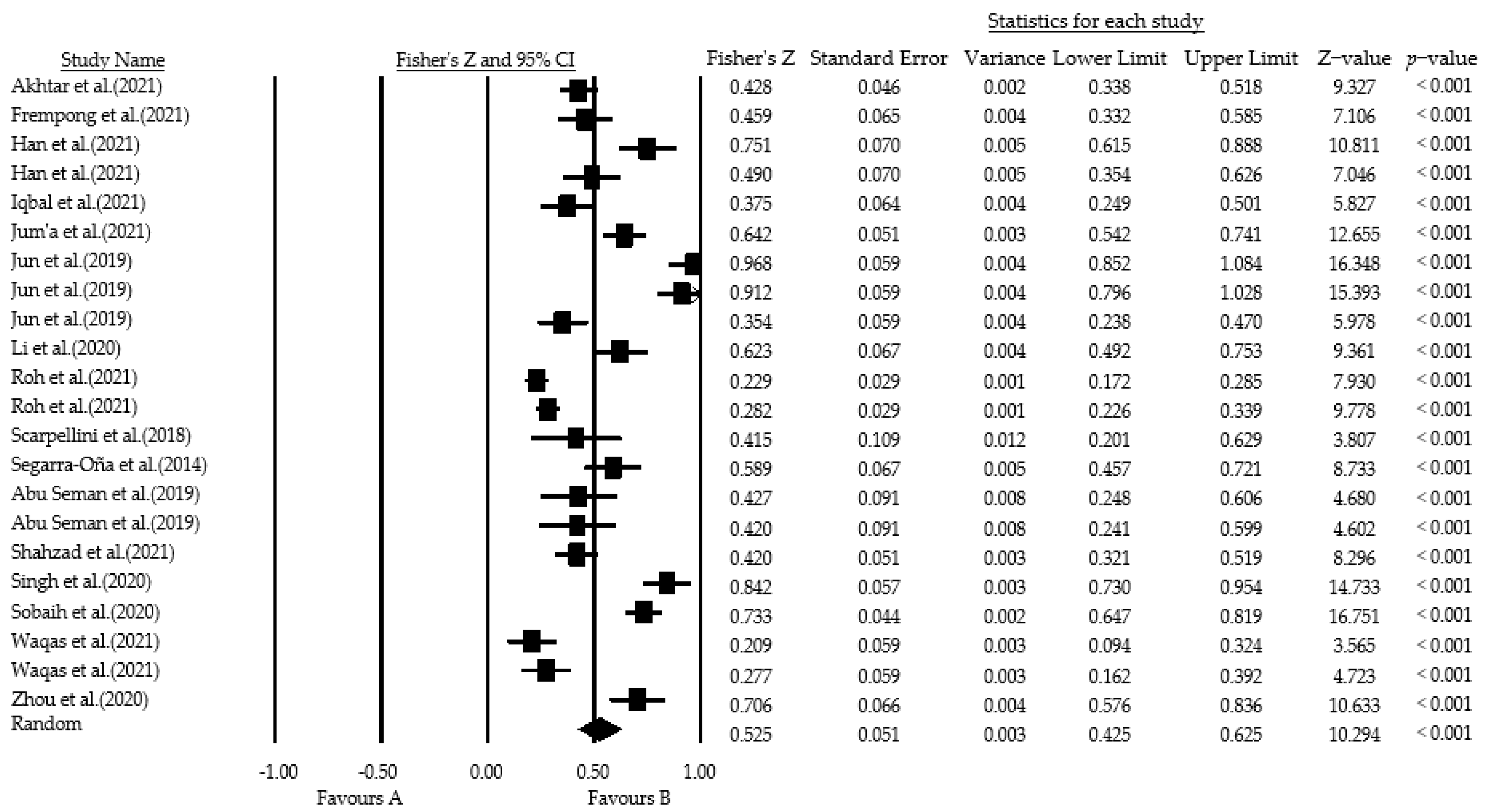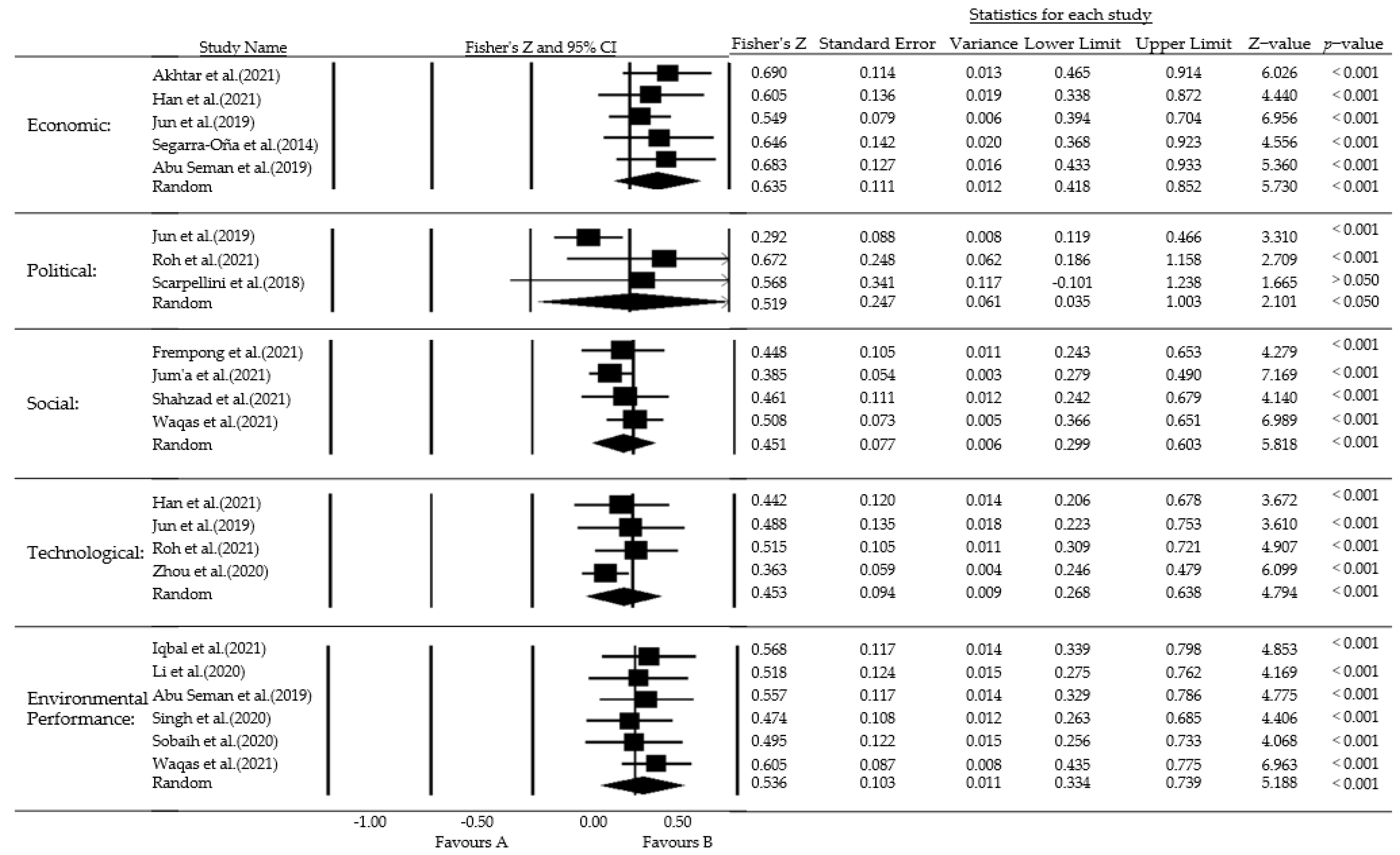Mechanism of Enterprise Green Innovation Behavior Considering Coevolution Theory
Abstract
:1. Introduction
2. Theories and Hypothesis
2.1. Theoretical Basis
2.2. Hypothesis Development
2.2.1. Environment
2.2.2. Enterprises
2.2.3. Moderator
3. Method and Data
3.1. Meta-Analysis
3.1.1. Data and Code
3.1.2. Publication Bias Test
3.1.3. Heterogeneity Test
3.1.4. Outlier Test
3.1.5. Sensitivity Analysis
4. Results and Discussion
4.1. Analysis and Discussion of Antecedent and Consequent Effects
4.2. Moderator Analysis and Discussion
5. Conclusions
5.1. Main Findings
- (1)
- The economic, political, social, and technological environments significantly and positively influence enterprise green innovation behavior. The effects of the economic, political, social, and technological environments are not consistent. Among them, the economic environment has the greatest impact on enterprise green innovation behavior, and the political environment has the second highest impact.
- (2)
- Enterprise green innovation behavior significantly and positively affects environmental performance.
- (3)
- Regional heterogeneity can moderate the effects of enterprise green innovation behavior and antecedent and consequence variables.
5.2. Policy Implications
5.3. Theoretical Contribution
5.4. Research Limitations and Perspectives
Author Contributions
Funding
Institutional Review Board Statement
Informed Consent Statement
Data Availability Statement
Conflicts of Interest
References
- United Nations Environment Programme. Stockholm +50 closes with call for urgent environmental, economic transformation. 2022. Available online: https://www.unep.org/zh-hans/xinwenyuziyuan/xinwengao/sidegeermo50guojihuiyibimuhuxujinjituijinhuanjinghejingjizhuanxing (accessed on 22 July 2022).
- Li, W.; Zhang, Y.; Zheng, M.; Li, X.; Cui, G.; Li, H. Research on green governance of Chinese listed companies and its evaluation. J. Manag. World 2019, 35, 126–133. [Google Scholar] [CrossRef]
- Jensen, M.C.; Meckling, W.H. Theory of the Firm: Managerial Behavior, Agency Costs and Ownership Structure. In Corporate Governance; Gower: New York, NY, USA, 1979; pp. 77–132. [Google Scholar]
- He, Z.-X.; Xu, S.-C.; Shen, W.-X.; Long, R.-Y.; Chen, H. Factors that influence corporate environmental behavior: Empirical analysis based on panel data in China. J. Clean. Prod. 2016, 133, 531–543. [Google Scholar] [CrossRef]
- Kuo, S.-Y.; Lin, P.-C. Determinants of green performance in container terminal operations: A lean management. J. Clean. Prod. 2020, 275, 123105. [Google Scholar] [CrossRef]
- Wang, J.; Xue, Y.; Sun, X.; Yang, J. Green learning orientation, green knowledge acquisition and ambidextrous green innovation. J. Clean. Prod. 2020, 250, 119475. [Google Scholar] [CrossRef]
- Rennings, K. Redefining innovation—Eco-innovation research and the contribution from ecological economics. Ecol. Econ. 2000, 32, 319–332. [Google Scholar] [CrossRef]
- Saunila, M.; Ukko, J.; Rantala, T. Sustainability as a driver of green innovation investment and exploitation. J. Clean. Prod. 2018, 179, 631–641. [Google Scholar] [CrossRef]
- National Development and Reform Commission, Ministry of Science and Technology of the People’s Republic of China. Guiding Opinions of the Ministry of Science and Technology on Building a Market-Oriented Green Technology Innovation System. Available online: https://www.gov.cn/zhengce/zhengceku/2019-09/29/content_5434807.htm (accessed on 22 July 2022).
- European Commission. Sustainable Product Policy & Ecodesign. 2022. Available online: https://ec.europa.eu/growth/industry/sustainability/sustainable-product-policy-ecodesign_en (accessed on 22 July 2022).
- He, L. Innovation Drives Low-Carbon Transformation and Promotes Green Economic Development. Science and Technology Daily. 2022. Available online: https://chn.oversea.cnki.net/KCMS/detail/detail.aspx?dbcode=CCND&dbname=CCNDTEMP&filename=KJRB202206150024&uniplatform=OVERSEA&v=1EOkYRn9V8tE6rkeZXKHWqimS1S2orRodU_lpPYXjRMSuAmOXMSUoO5SwAbHu16kOKhr07n-6FU%3d (accessed on 23 July 2022).
- Li, X.; Du, J.; Long, H. Dynamic analysis of international green behavior from the perspective of the mapping knowledge domain. Environ. Sci. Pollut. Res. 2019, 26, 6087–6098. [Google Scholar] [CrossRef]
- Li, X.; He, J.; Huang, Y.; Li, J.; Liu, X.; Dai, J. Predicting the factors influencing construction enterprises’ adoption of green development behaviors using artificial neural network. Humanit. Soc. Sci. Commun. 2022, 9, 238. [Google Scholar] [CrossRef]
- Li, X.; Li, J.; Huang, Y.; He, J.; Liu, X.; Dai, J.; Shen, Q. Construction enterprises’ adoption of green development behaviors: An agent-based modeling approach. Humanit. Soc. Sci. Commun. 2022, 9, 244. [Google Scholar] [CrossRef]
- Li, X.; Huang, R.; Dai, J.; Li, J.; Shen, Q. Research on the evolutionary game of construction and demolition waste (cdw) recycling units’ green behavior, considering remanufacturing capability. Int. J. Environ. Res. Public Health 2021, 18, 9268. [Google Scholar] [CrossRef]
- Li, X.; Long, H. Research Focus, Frontier and Knowledge Base of Green Technology in China: Metrological Research Based on Mapping Knowledge Domains. Pol. J. Environ. Stud. 2020, 29, 3003–3011. [Google Scholar] [CrossRef]
- Song, W.; Yu, H. Green Innovation Strategy and Green Innovation: The Roles of Green Creativity and Green Organizational Identity. Corp. Soc. Responsib. Environ. Manag. 2018, 25, 135–150. [Google Scholar] [CrossRef]
- Li, X.; Hu, Z.; Zhang, Q. Environmental regulation, economic policy uncertainty, and green technology innovation. Clean Technol. Environ. Policy 2021, 23, 2975–2988. [Google Scholar] [CrossRef]
- Hao, X.; Chen, F.; Chen, Z. Does green innovation increase enterprise value? Bus. Strat. Environ. 2022, 31, 1232–1247. [Google Scholar] [CrossRef]
- Wang, C.H.; Juo, W. An environmental policy of green intellectual capital: Green innovation strategy for performance sustainability. Bus. Strat. Environ. 2021, 30, 3241–3254. [Google Scholar] [CrossRef]
- Wang, C.H. How organizational green culture influences green performance and competitive advantage. J. Manuf. Technol. Manag. 2019, 30, 666–683. [Google Scholar] [CrossRef]
- Qin, X.; Xiaoyu, Q. The Antecedents and Consequences of Green Innovation: A Meta-Analysis. 2022. Available online: https://kns.cnki.net/kcms/detail/53.1193.F.20220513.2000.002.html (accessed on 22 July 2022).
- Tariq, A.; Badir, Y.F.; Tariq, W.; Bhutta, U.S. Drivers and consequences of green product and process innovation: A systematic review, conceptual framework, and future outlook. Technol. Soc. 2017, 51, 8–23. [Google Scholar] [CrossRef]
- Yang, X.; Guo, Y.; Liu, Q.; Zhang, D. Dynamic Co-evolution analysis of low-carbon technology innovation compound system of new energy enterprise based on the perspective of sustainable development. J. Clean. Prod. 2022, 349, 131330. [Google Scholar] [CrossRef]
- Flier, B.; Bosch, F.A.J.V.D.; Volberda, H.W. Co-evolution in Strategic Renewal Behaviour of British, Dutch and French Financial Incumbents: Interaction of Environmental Selection, Institutional Effects and Managerial Intentionality. J. Manag. Stud. 2003, 40, 2163–2187. [Google Scholar] [CrossRef]
- Joel, A.C.B.; Singh, J.V. Organizational niches and the dynamics of organizational founding. Organ. Sci. 1994, 5, 483–501. [Google Scholar]
- Lewin, A.Y.; Volberda, H.W. Prolegomena on Coevolution: A Framework for Research on Strategy and New Organizational Forms. Organ. Sci. 1999, 10, 519–534. [Google Scholar] [CrossRef]
- Lundan, S.; Cantwell, J. The local co-evolution of firms and governments in the Information Age. J. Int. Bus. Stud. 2020, 51, 1516–1528. [Google Scholar] [CrossRef] [PubMed]
- García-Cabrera, A.M.; Durán-Herrera, J.J.; Suárez-Ortega, S.M. Multinationals’ political activity for institutional change: Evidence from Spain during the international crisis of 2008. Eur. Manag. J. 2019, 37, 541–551. [Google Scholar] [CrossRef]
- Singh, S.K.; del Giudice, M.; Chierici, R.; Graziano, D. Green innovation and environmental performance: The role of green transformational leadership and green human resource management. Technol. Forecast. Soc. Chang. 2020, 150, 119762. [Google Scholar] [CrossRef]
- Xie, X.M.; Huo, J.G.; Zou, H.L. Green process innovation, green product innovation, and corporate financial performance: A content analysis method. J. Bus. Res. 2019, 101, 697–706. [Google Scholar] [CrossRef]
- Xie, X.; Zhu, Q.; Wang, R. Turning green subsidies into sustainability: How green process innovation improves firms’ green image. Bus. Strat. Environ. 2019, 28, 1416–1433. [Google Scholar] [CrossRef]
- Wei, L.; Zhu, R.; Yuan, C. Embracing green innovation via green supply chain learning: The moderating role of green technology turbulence. Sustain. Dev. 2020, 28, 155–168. [Google Scholar] [CrossRef]
- Lv, H.; Li, D. Impacts of heterogeneous green consumers on green innovation in electric vehicle and charging pile firms. Sustain. Prod. Consum. 2021, 28, 1216–1231. [Google Scholar] [CrossRef]
- Sun, Y.; Sun, H. Green Innovation Strategy and Ambidextrous Green Innovation: The Mediating Effects of Green Supply Chain Integration. Sustainability 2021, 13, 4876. [Google Scholar] [CrossRef]
- Lian, G.; Xu, A.; Zhu, Y. Substantive green innovation or symbolic green innovation? The impact of er on enterprise green innovation based on the dual moderating effects. J. Innov. Knowl. 2022, 7, 100203. [Google Scholar] [CrossRef]
- Nie, P.Y.; Wen, H.-X.; Wang, C. Cooperative green innovation. Environ. Sci. Pollut. Res. 2022, 29, 30150–30158. [Google Scholar] [CrossRef] [PubMed]
- Zhou, J.; Sawyer, L.; Safi, A. Institutional Pressure and Green Product Success: The Role of Green Transformational Leadership, Green Innovation, and Green Brand Image. Front. Psychol. 2021, 12, 704855. [Google Scholar] [CrossRef]
- Yuan, B.; Cao, X. Do corporate social responsibility practices contribute to green innovation? The mediating role of green dynamic capability. Technol. Soc. 2022, 68, 101868. [Google Scholar] [CrossRef]
- Yousaf, Z. Go for green: Green innovation through green dynamic capabilities: Accessing the mediating role of green practices and green value co-creation. Environ. Sci. Pollut. Res. 2021, 28, 54863–54875. [Google Scholar] [CrossRef] [PubMed]
- Ross, L.F., Sr. So You Want to Be a Strategic Leader: Here Are the Essentials to Get You Started; Xlibris Corporation: Bloomington, IN, USA, 2008. [Google Scholar]
- Li, F.; Cao, X.; Ou, R. A network-based evolutionary analysis of the diffusion of cleaner energy substitution in enterprises: The roles of PEST factors. Energy Policy 2021, 156, 112385. [Google Scholar] [CrossRef]
- Chen, Y.; Chang, C.; Wu, F. Origins of green innovations: The differences between proactive and reactive green innovations. Manag. Decis. 2012, 50, 368–398. [Google Scholar] [CrossRef]
- Pham, H.T.; Pham, T.; Quang, H.T.; Dang, C.N. Impact of transformational leadership on green learning and green innovation in construction supply chains. Eng. Constr. Arch. Manag. 2022. ahead-of-print. [Google Scholar] [CrossRef]
- Abu Seman, N.A.; Govindan, K.; Mardani, A.; Zakuan, N.; Saman, M.Z.M.; Hooker, R.E.; Ozkul, S. The mediating effect of green innovation on the relationship between green supply chain management and environmental performance. J. Clean. Prod. 2019, 229, 115–127. [Google Scholar] [CrossRef]
- Jun, W.; Ali, W.; Bhutto, M.Y.; Hussain, H.; Khan, N.A. Examining the determinants of green innovation adoption in SMEs: A PLS-SEM approach. Eur. J. Innov. Manag. 2021, 24, 67–87. [Google Scholar] [CrossRef]
- Li, X.; Dai, J.; Li, J.; He, J.; Liu, X.; Huang, Y.; Shen, Q. Research on the Impact of Enterprise Green Development Behavior: A Meta-Analytic Approach. Behav. Sci. 2022, 12, 35. [Google Scholar] [CrossRef]
- Li, X.; Dai, J.; Zhu, X.; He, J.; Li, J.; Liu, X.; Huang, Y.; Shen, Q. What Is the Mechanism of Government Green Development Behavior Considering Multi-Agent Interaction? A Meta-Analysis. Int. J. Environ. Res. Public Health 2022, 19, 8263. [Google Scholar] [CrossRef]
- Arranz, N.; Arroyabe, C.F.; de Arroyabe, J.C.F. The effect of regional factors in the development of eco-innovations in the firm. Bus. Strat. Environ. 2019, 28, 1406–1415. [Google Scholar] [CrossRef]
- Scholes, K.; Johnson, G.; Whittington, R. Exploring Corporate Strategy; Financial Times Prentice Hall Hoboken: Upper Saddle River, NJ, USA, 2002. [Google Scholar]
- Li, X.; Huang, Y.; Li, J.; Liu, X.; He, J.; Dai, J. The Mechanism of Influencing Green Technology Innovation Behavior: Evidence from Chinese Construction Enterprises. Buildings 2022, 12, 237. [Google Scholar] [CrossRef]
- Li, X.; Du, J.; Long, H. Mechanism for Green Development Behavior and Performance of Industrial Enterprises (GDBP-IE) Using Partial Least Squares Structural Equation Modeling (PLS-SEM). Int. J. Environ. Res. Public Health 2020, 17, 8450. [Google Scholar] [CrossRef] [PubMed]
- Wang, J.; Ma, Y.; Li, X. Does external pressure promote green innovation?—The ambidextrous impact of government super-vision and media supervision. Ind. Econ. Rev. 2021, 12, 66–81. [Google Scholar] [CrossRef]
- Peng, H.; Shen, N.; Ying, H.; Wang, Q. Can environmental regulation directly promote green innovation behavior?—Based on situation of industrial agglomeration. J. Clean. Prod. 2021, 314, 128044. [Google Scholar] [CrossRef]
- Ji, H.; Miao, Z. Corporate social responsibility and collaborative innovation: The role of government support. J. Clean. Prod. 2020, 260, 121028. [Google Scholar] [CrossRef]
- Triguero, A.; Moreno-Mondéjar, L.; Davia, M.A. Leaders and laggards in environmental innovation: An empirical analysis of SMEs in Europe. Bus. Strategy Environ. 2014, 25, 28–39. [Google Scholar] [CrossRef]
- Roh, T.; Lee, K.; Yang, J.Y. How do intellectual property rights and government support drive a firm’s green innovation? The mediating role of open innovation. J. Clean. Prod. 2021, 317, 128422. [Google Scholar] [CrossRef]
- International Organization for Standardization. Environmental Management Systems: Requirements with Guidance for Use; International Organization for Standardization: Geneva, Switzerland, 2015; Available online: https://www.iso.org/standard/60857.html (accessed on 15 August 2022).
- Semenova, N.; Hassel, L.G. On the Validity of Environmental Performance Metrics. J. Bus. Ethics 2015, 132, 249–258. [Google Scholar] [CrossRef]
- Li, L.; Msaad, H.; Sun, H.; Tan, M.X.; Lu, Y.; Lau, A.K. Green Innovation and Business Sustainability: New Evidence from Energy Intensive Industry in China. Int. J. Environ. Res. Public Health 2020, 17, 7826. [Google Scholar] [CrossRef] [PubMed]
- Santoalha, A.; Boschma, R. Diversifying in green technologies in European regions: Does political support matter? Reg. Stud. 2021, 55, 182–195. [Google Scholar] [CrossRef] [Green Version]
- Wang, Y.; Zhao, N.; Lei, X.; Long, R. Green Finance Innovation and Regional Green Development. Sustainability 2021, 13, 8230. [Google Scholar] [CrossRef]
- Zhang, W.; Li, G.; Guo, F. Does carbon emissions trading promote green technology innovation in China? Appl. Energy 2022, 315, 119012. [Google Scholar] [CrossRef]
- Borenstein, L.V.H.M.; Higgins, J.P.T.; Rothstein, H.R. Front matter. In Introduction to Meta-Analysis; John Wiley and Sons: New York, NY, USA, 2009; pp. A7–A10. [Google Scholar]
- L’Abbé, K.A.; Detsky, A.S.; O’Rourke, K. Meta-Analysis in Clinical Research. Ann. Intern. Med. 1987, 107, 224–233. [Google Scholar] [CrossRef] [PubMed]
- Slavin, R.E. Meta-analysis in education: How has it been used? Educ. Res. 1984, 13, 6–15. [Google Scholar] [CrossRef]
- Schiederig, T.; Tietze, F.; Herstatt, C. Green innovation in technology and innovation management—An exploratory literature review. R&D Manag. 2012, 42, 180–192. [Google Scholar] [CrossRef]
- Takalo, S.K.; Tooranloo, H.S.; Parizi, Z.S. Green innovation: A systematic literature review. J. Clean. Prod. 2021, 279, 122474. [Google Scholar] [CrossRef]
- Carney, M.; Gedajlovic, E.R.; Heugens, P.P.M.A.R.; van Essen, M.; van Oosterhout, J. Business Group Affiliation, Performance, Context, and Strategy: A Meta-analysis. Acad. Manag. J. 2011, 54, 437–460. [Google Scholar] [CrossRef] [Green Version]
- Dixon-Fowler, H.R.; Slater, D.J.; Johnson, J.L.; Ellstrand, A.E.; Romi, A.M. Beyond “Does it Pay to be Green?” A Meta-Analysis of Moderators of the CEP–CFP Relationship. J. Bus. Ethics 2013, 112, 353–366. [Google Scholar] [CrossRef] [Green Version]
- Sandelowski, M.; Docherty, S.; Emden, C. Focus on qualitative methods. Qualitative metasynthesis: Issues and techniques. Res. Nurs. Health 1997, 20, 365–371. [Google Scholar] [CrossRef]
- Borenstein, M.; Hedges, L.V.; Higgins, J.P.T.; Rothstein, H.R. How a meta-analysis works. In Introduction to Meta-Analysis; John Wiley & Sons: New York, NY, USA, 2009; pp. 1–22. [Google Scholar]
- Fisher, R.A. Frequency Distribution of the Values of the Correlation Coeffients in Samples from an Indefinitely Large Population. Biometrika 1915, 10, 507–521. [Google Scholar] [CrossRef] [Green Version]
- Akhtar, S.; Martins, J.M.; Mata, P.N.; Tian, H.; Naz, S.; Dâmaso, M.; Santos, R.S. Assessing the Relationship between Market Orientation and Green Product Innovation: The Intervening Role of Green Self-Efficacy and Moderating Role of Resource Bricolage. Sustainability 2021, 13, 11494. [Google Scholar] [CrossRef]
- Frempong, M.F.; Mu, Y.; Adu-Yeboah, S.S.; Hossin, M.A.; Adu-Gyamfi, M. Corporate Sustainability and Firm Performance: The Role of Green Innovation Capabilities and Sustainability-Oriented Supplier–Buyer Relationship. Sustainability 2021, 13, 10414. [Google Scholar] [CrossRef]
- Han, M.; Xu, B. Distance with customers effects on green product innovation in smes: A way through green value co-creation. Sage Open 2021, 11, 1–11. [Google Scholar] [CrossRef]
- Iqbal, Q.; Ahmad, N.; Li, Y. Sustainable Leadership in Frontier Asia Region: Managerial Discretion and Environmental Innovation. Sustainability 2021, 13, 5002. [Google Scholar] [CrossRef]
- Jum’A, L.; Zimon, D.; Ikram, M.; Madzík, P. Towards a sustainability paradigm; the nexus between lean green practices, sustainability-oriented innovation and Triple Bottom Line. Int. J. Prod. Econ. 2022, 245, 108393. [Google Scholar] [CrossRef]
- Scarpellini, S.; Marín-Vinuesa, L.M.; Portillo-Tarragona, P.; Moneva, J.M. Defining and measuring different dimensions of financial resources for business eco-innovation and the influence of the firms’ capabilities. J. Clean. Prod. 2018, 204, 258–269. [Google Scholar] [CrossRef] [Green Version]
- Segarra-Oña, M.; Peiro-Signes, A.; Payá-Martínez, A. Factors Influencing Automobile Firms’ Eco-Innovation Orientation. Eng. Manag. J. 2014, 26, 31–38. [Google Scholar] [CrossRef]
- Shahzad, M.; Qu, Y.; Zafar, A.U.; Appolloni, A. Does the interaction between the knowledge management process and sustainable development practices boost corporate green innovation? Bus. Strat. Environ. 2021, 30, 4206–4222. [Google Scholar] [CrossRef]
- Sobaih, A.E.E.; Hasanein, A.; Elshaer, I. Influences of Green Human Resources Management on Environmental Performance in Small Lodging Enterprises: The Role of Green Innovation. Sustainability 2020, 12, 10371. [Google Scholar] [CrossRef]
- Waqas, M.; Honggang, X.; Ahmad, N.; Khan, S.A.R.; Iqbal, M. Big data analytics as a roadmap towards green innovation, competitive advantage and environmental performance. J. Clean. Prod. 2021, 323, 128998. [Google Scholar] [CrossRef]
- Zhou, M.; Govindan, K.; Xie, X. How fairness perceptions, embeddedness, and knowledge sharing drive green innovation in sustainable supply chains: An equity theory and network perspective to achieve sustainable development goals. J. Clean. Prod. 2020, 260, 120950. [Google Scholar] [CrossRef]
- Rosenthal, R. The file drawer problem and tolerance for null results. Psychol. Bull. 1979, 86, 638. [Google Scholar] [CrossRef]
- Begg, C.B.; Mazumdar, M. Operating Characteristics of a Rank Correlation Test for Publication Bias. Biometrics 1994, 50, 1088–1101. [Google Scholar] [CrossRef] [PubMed]
- Egger, M.; Smith, G.D.; Schneider, M.; Minder, C. Bias in meta-analysis detected by a simple, graphical test. BMJ 1997, 315, 629–634. [Google Scholar] [CrossRef] [Green Version]
- Borenstein, M.; Hedges, L.V.; Higgins, J.P.T.; Rothstein, H.R. Identifying and Quantifying Heterogeneity. In Introduction to Meta-Analysis; John Wiley & Sons: New York, NY, USA, 2009; pp. 107–125. [Google Scholar] [CrossRef]
- Higgins, J.P.; Thompson, S.G.; Deeks, J.J.; Altman, D.G. Measuring inconsistency in meta-analyses. BMJ 2003, 327, 557–560. [Google Scholar] [CrossRef] [Green Version]
- Borenstein, M.; Hedges, L.V.; Higgins, J.P.T.; Rothstein, H.R. Reporting the Results of a Meta-Analysis. In Introduction to Meta-Analysis; John Wiley & Sons: New York, NY, USA, 2009; pp. 365–370. [Google Scholar] [CrossRef]
- International Energy Agency. Policies Database. 2022. Available online: https://www.iea.org/policies?type=Regulation (accessed on 2 June 2022).
- Li, C.; Xia, W.; Wang, L. The transfer mechanism of pollution industry in China under multi-factor combination model—Based on the perspective of industry, location, and environment. Environ. Sci. Pollut. Res. 2021, 28, 60167–60181. [Google Scholar] [CrossRef]
- Ministry of Ecology and Environment of the People’s Republic of China. Eco-Environmental Statistics Annual Report. 2022. Available online: https://www.mee.gov.cn/hjzl/sthjzk/zghjzkgb/202205/P020220608338202870777.pdf (accessed on 22 July 2022).
- Congressional Research Service. Federal Research and Development (R&D) Funding: Fy2021. 2020. Available online: https://crsreports.congress.gov (accessed on 21 July 2022).
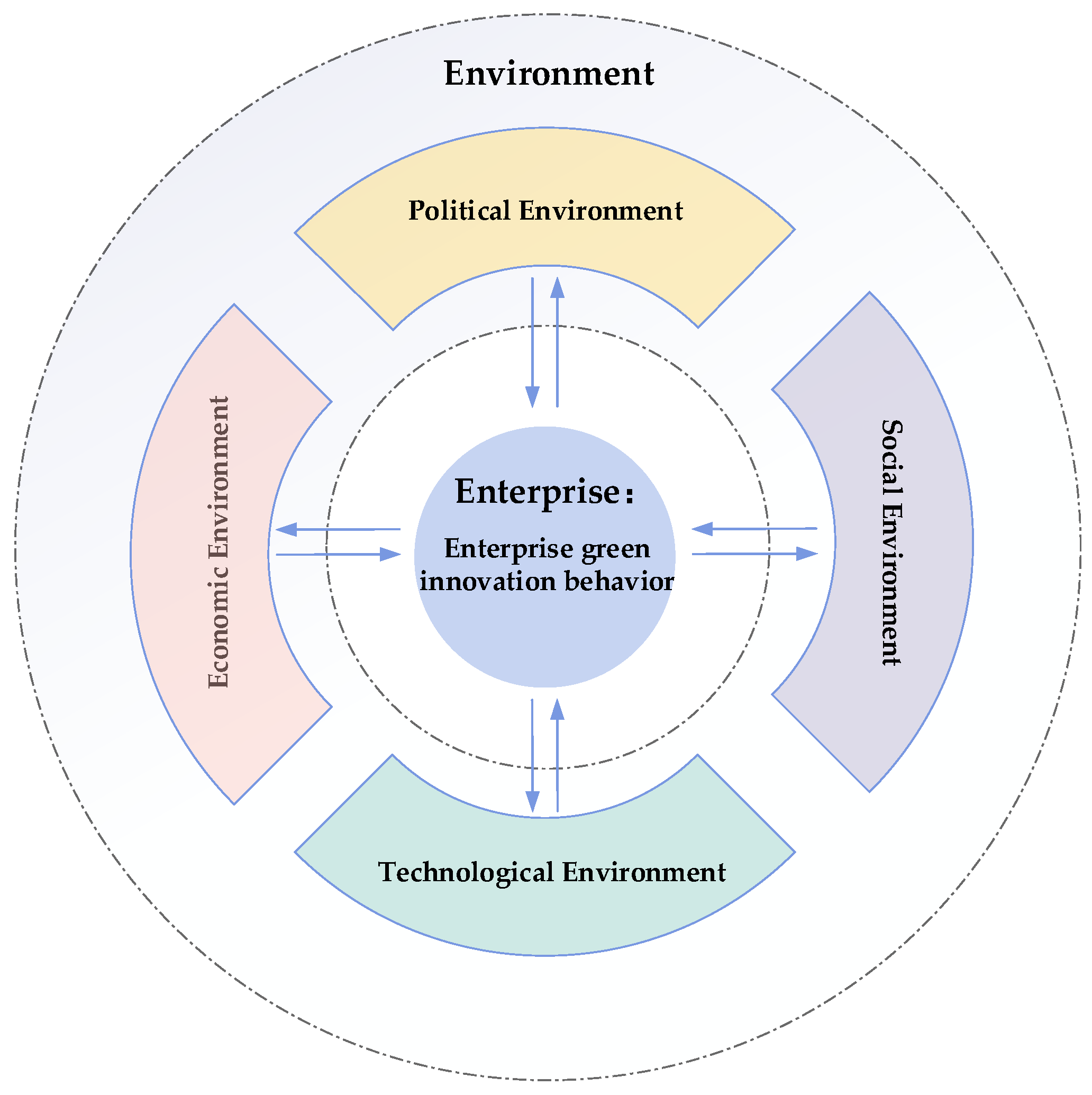
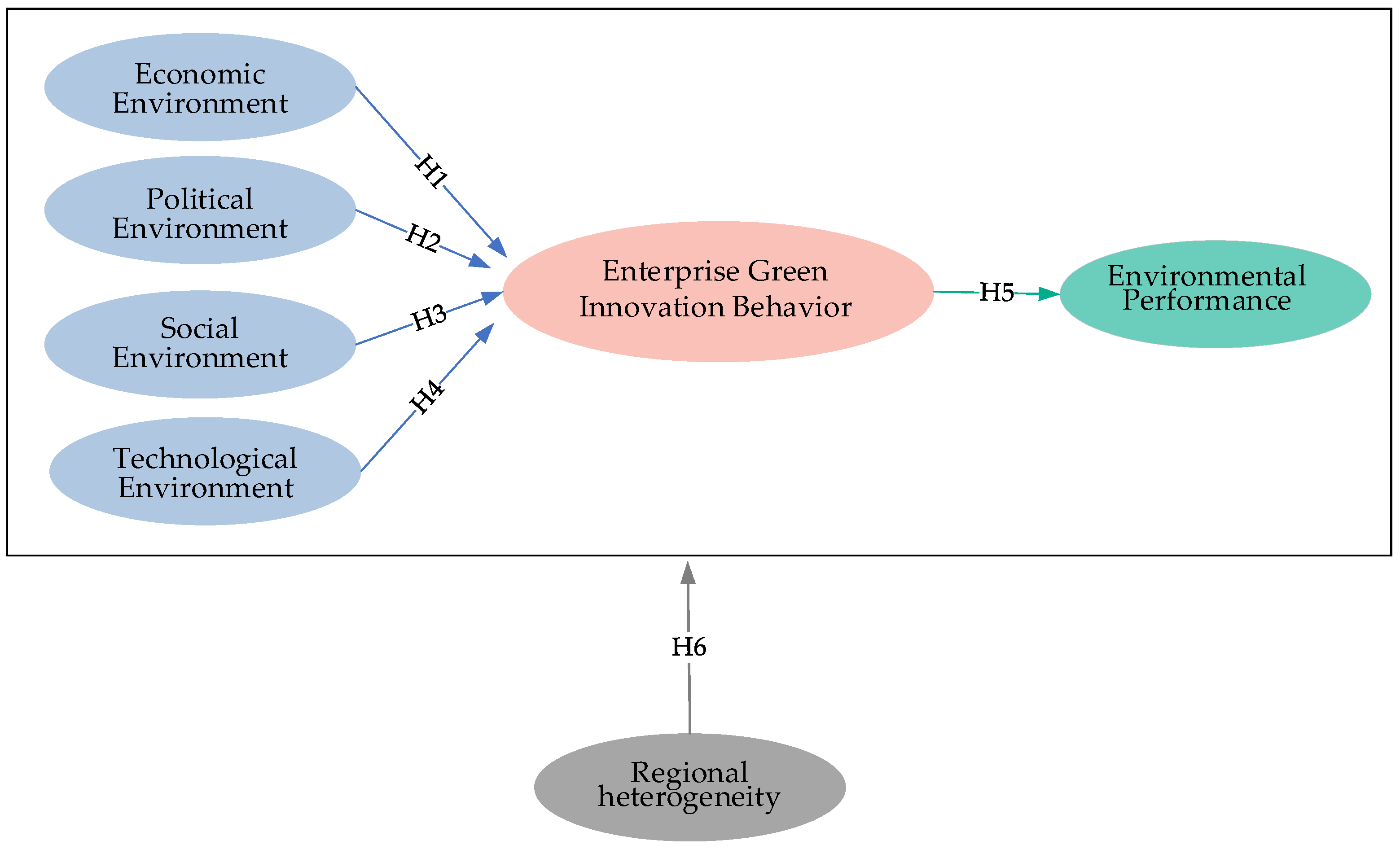
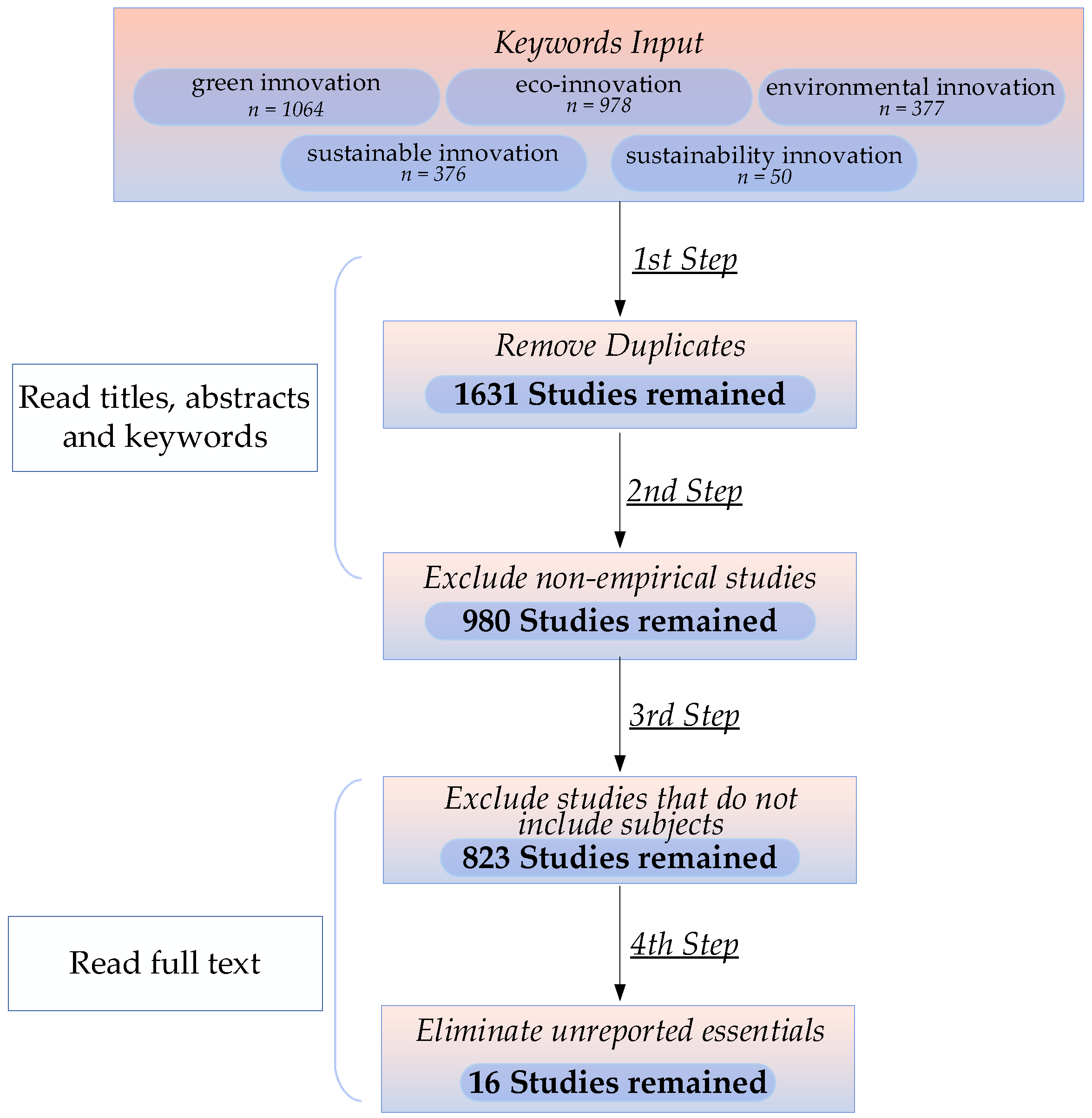
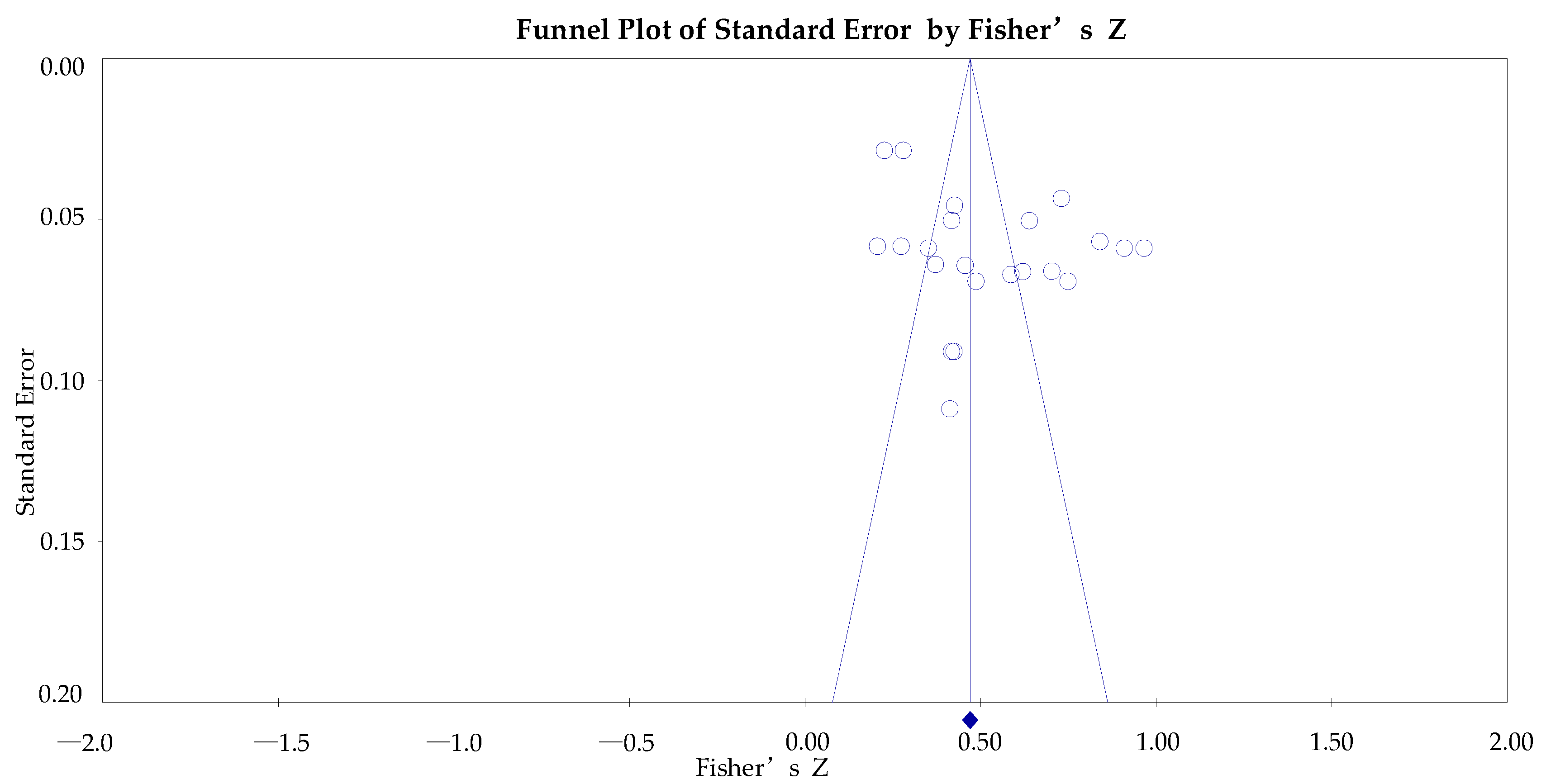
| Researcher | Economic Environment | Political Environment | Social Environment | Technological Environment | Environmental Performance | Moderator | Quantitative Research |
|---|---|---|---|---|---|---|---|
| Tariq et al. (2017) [23] | √ | √ | √ | √ | √ | √ | |
| Abu Seman et al. (2019) [45] | √ | √ | |||||
| Jun et al. (2019) [46] | √ | √ | √ | √ | |||
| Qin et al. (2022) [22] | √ | √ | √ | ||||
| Yang et al. (2022) [24] | √ | √ | √ | √ | √ | ||
| This research | √ | √ | √ | √ | √ | √ | √ |
| Author Year | Outcome | Sample Size | Fisher’s Z | Standard Error | Region |
|---|---|---|---|---|---|
| Abu Seman et al. (2019) [45] | Economic, Environmental Performance | 123 | 0.427, 0.420 | 0.091 | Malaysia |
| Akhtar et al. (2021) [74] | Economic | 477 | 0.428 | 0.046 | Pakistan |
| Frempong et al. (2021) [75] | Social | 243 | 0.459 | 0.065 | Ghana |
| Han et al. (2021) [76] | Technological, Economic | 210 | 0.751, 0.490 | 0.070 | China |
| Iqbal et al. (2021) [77] | Environmental Performance | 245 | 0.375 | 0.064 | Various |
| Jum’a et al. (2021) [78] | Social | 392 | 0.642 | 0.051 | Jordan |
| Jun et al. (2019) [46] | Political, Economic, Technological | 288 | 0.968, 0.912, 0.354 | 0.059 | Pakistan |
| Li et al. (2020) [60] | Environmental Performance | 229 | 0.623 | 0.067 | China |
| Roh et al.(2021) [57] | Political, Technological | 1203 | 0.229, 0.282 | 0.029 | South Korea |
| Scarpellini et al. (2018) [79] | Political | 87 | 0.415 | 0.109 | Spain |
| Segarra-Oña et al. (2014) [80] | Economic | 223 | 0.589 | 0.067 | Spain |
| Shahzad et al. (2021) [81] | Social | 393 | 0.420 | 0.051 | Pakistan |
| Singh et al. (2020) [30] | Environmental Performance | 309 | 0.842 | 0.057 | The United Arab Emirates |
| Sobaih et al. (2020) [82] | Environmental Performance | 525 | 0.733 | 0.044 | Egypt |
| Waqas et al. (2021) [83] | Social, Environmental Performance | 294 | 0.209, 0.277 | 0.059 | China |
| Zhou et al. (2020) [84] | Technological | 230 | 0.706 | 0.066 | China |
| Outcome | Rosenthal‘S Fail-Safe N | Begg and Mazumdar Rank Correlation p-Value | Egger’s Regression (2-Tailed) | ||||
|---|---|---|---|---|---|---|---|
| Z-Value | p-Value | α | p-Value | Low Limit | Upper Limit | ||
| Economic | 22.316 | <0.001 | 0.050 | 1.000 | 0.773 | −25.687 | 31.333 |
| Political | 15.663 | <0.001 | 0.050 | 0.602 | 0.583 | −121.627 | 137.267 |
| Social | 16.390 | <0.001 | 0.050 | 1.000 | 0.104 | −76.040 | 54.621 |
| Technological | 16.717 | <0.001 | 0.050 | 0.174 | 0.181 | −7.469 | 20.661 |
| Environmental Performance | 22.388 | <0.001 | 0.050 | 0.573 | 0.375 | −30.598 | 15.437 |
| Model | k | Combined Effect Size | 95% Confidence Interval | Q-Value | df | p-Value | I2 | |
|---|---|---|---|---|---|---|---|---|
| LL | UL | |||||||
| Fixed | 22 | 0.470 | 0.448 | 0.492 | 405.242 | 21 | <0.001 | 94.818 |
| Random | 22 | 0.525 | 0.425 | 0.625 | ||||
| Category | Outcome | k | Combined Effect Size | 95% CI | p-Value | Total Effect Size | |
|---|---|---|---|---|---|---|---|
| LL | UL | ||||||
| Environment | Economic | 5 | 0.635 | 0.418 | 0.852 | <0.001 | 0.521 |
| Political | 2 | 0.519 | 0.035 | 1.003 | <0.001 | ||
| Social | 5 | 0.451 | 0.299 | 0.603 | <0.001 | ||
| Technological | 4 | 0.453 | 0.268 | 0.638 | <0.001 | ||
| Enterprise | Environmental Performance | 6 | 0.536 | 0.334 | 0.739 | <0.001 | 0.536 |
| Region | k | Effect Size | 95% CI | 2-Tailed Test: p-Value | Q Statistics | I2 | τ2 | |||
|---|---|---|---|---|---|---|---|---|---|---|
| LL | UL | Q-Value | df | p-Value | ||||||
| China | 6 | 0.371 | 0.333 | 0.410 | <0.001 | 73.592 | 5 | <0.001 | 93.206 | 0.036 |
| Egypt | 1 | 0.733 | 0.647 | 0.819 | <0.001 | 0.000 | 0 | >0.050 | 0.000 | 0.000 |
| Ghana | 1 | 0.490 | 0.354 | 0.626 | <0.001 | 0.000 | 0 | >0.050 | 0.000 | 0.032 |
| Jordan | 1 | 0.912 | 0.796 | 1.028 | <0.001 | 0.000 | 0 | >0.050 | 0.000 | 0.000 |
| Malaysia | 2 | 0.439 | 0.365 | 0.512 | <0.001 | 0.146 | 1 | >0.050 | 0.000 | 0.000 |
| Pakistan | 5 | 0.362 | 0.321 | 0.403 | <0.001 | 69.338 | 4 | <0.001 | 94.231 | 0.042 |
| South Korea | 2 | 0.541 | 0.428 | 0.653 | <0.001 | 1.828 | 1 | >0.050 | 45.297 | 0.007 |
| Spain | 2 | 0.424 | 0.297 | 0.550 | <0.001 | 0.003 | 1 | >0.050 | 0.000 | 0.000 |
| The United Arab Emirates | 1 | 0.842 | 0.730 | 0.954 | <0.001 | 0.000 | 0 | >0.050 | 0.000 | 0.000 |
| Various | 1 | 0.968 | 0.852 | 1.084 | <0.001 | 0.000 | 0 | >0.050 | 0.000 | 0.000 |
| Total within | 144.907 | 12 | <0.001 | |||||||
| Total between | 260.334 | 9 | <0.001 | |||||||
Publisher’s Note: MDPI stays neutral with regard to jurisdictional claims in published maps and institutional affiliations. |
© 2022 by the authors. Licensee MDPI, Basel, Switzerland. This article is an open access article distributed under the terms and conditions of the Creative Commons Attribution (CC BY) license (https://creativecommons.org/licenses/by/4.0/).
Share and Cite
Li, X.; Dai, J.; He, J.; Li, J.; Huang, Y.; Liu, X.; Shen, Q. Mechanism of Enterprise Green Innovation Behavior Considering Coevolution Theory. Int. J. Environ. Res. Public Health 2022, 19, 10453. https://doi.org/10.3390/ijerph191610453
Li X, Dai J, He J, Li J, Huang Y, Liu X, Shen Q. Mechanism of Enterprise Green Innovation Behavior Considering Coevolution Theory. International Journal of Environmental Research and Public Health. 2022; 19(16):10453. https://doi.org/10.3390/ijerph191610453
Chicago/Turabian StyleLi, Xingwei, Jiachi Dai, Jinrong He, Jingru Li, Yicheng Huang, Xiang Liu, and Qiong Shen. 2022. "Mechanism of Enterprise Green Innovation Behavior Considering Coevolution Theory" International Journal of Environmental Research and Public Health 19, no. 16: 10453. https://doi.org/10.3390/ijerph191610453
APA StyleLi, X., Dai, J., He, J., Li, J., Huang, Y., Liu, X., & Shen, Q. (2022). Mechanism of Enterprise Green Innovation Behavior Considering Coevolution Theory. International Journal of Environmental Research and Public Health, 19(16), 10453. https://doi.org/10.3390/ijerph191610453







